The calcareous grassland habitat in Wales is restricted to the areas on the Carboniferous Limestone, which notably include the south facing cliffs of Gower and Pembrokeshire, and the Great Orme headland. These areas are all renowned for their rich limestone floras, which include several nationally rare species. The reference states and modified states for calcareous grassland in Wales are described in the sections below.
Calcareous grassland
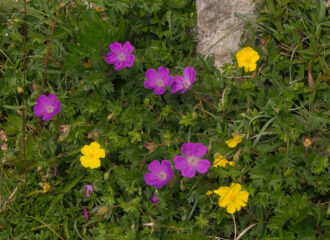
Reference state 1 – Lightly-grazed pasture
The more diverse coastal calcareous grasslands occur on relatively thin limestone soils and are maintained either directly or indirectly by stock grazing: some areas are intentionally managed as pasture, other areas incidentally. The best examples of calcareous pasture in Wales tend to be lightly grazed by sheep, allowing the sward to have an open structure…
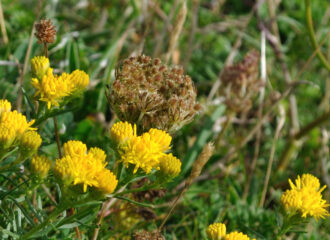
Reference state 1a – Short pasture
Some of the shorter limestone grasslands that maintained by salt deposition and winter sheep-grazing can also be of high biodiversity importance and support rare plant species, such as the goldilocks aster (Aster linoosyris) seen here and are also important feeding habitats for the coastal chough (Pyrrhocorax pyrrhocorax) populations in Wales.
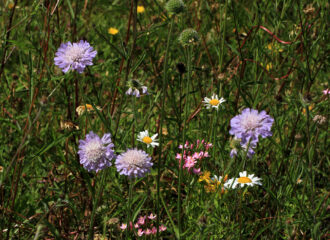
Reference state 2 – Meadow
Calcareous grassland meadows are a relatively scarce habitat in Wales, confined mostly to the county of Gwent in the south-east of the country. They are both species-rich and colourful and attract an abundant pollinator fauna, including marbled white (Melanargia galathea) butterflies. As with other meadows, their continued existence depends on the exclusion of stock throughout…
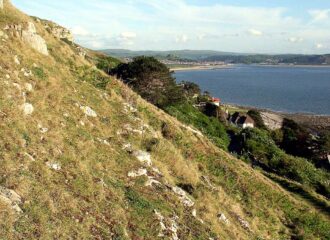
Reference state 3 – Xerophytic grassland
In Wales, this type of grassland typically occurs on steep slopes with thin limestone soils and scattered rocky outcrops. The habitat is not particularly species-rich as only specialist xerophyte species can thrive there. However, some of the specialist plants and invertebrates found in these locations are of considerable interest for being locally distributed in Wales…
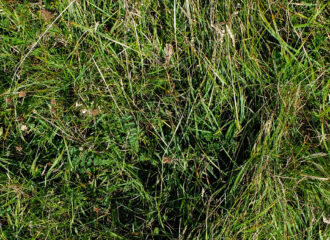
Reference state 4 – Under-managed grassland
Neglected or under-managed calcareous grasslands are ultimately at risk of being lost to bracken or scrub, though the first indications include an increase in sward height, an increase in the cover of competitive grasses and sedges and a corresponding decline in the associated ‘stress tolerating’ species. In isolated sites it can be difficult to restore…
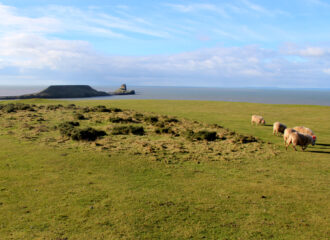
Modified state 1 – Overgrazed grassland
In keeping with other types of grassland, periods of intensive sheep-grazing and the resulting eutrophication reduces the floristic diversity of calcareous grasslands – with true calcicole species declining in frequency while species that favour eutrophic conditions increase. Since the 1990s, the problems associated with eutrophication have been exacerbated by the deposition of atmospheric nitrogen, offsetting…
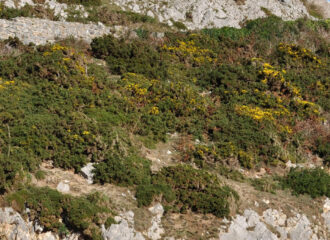
Modified state 2 – Grassland/scrub mosaic
After the foot and mouth pandemics in 1967 and 2001 and subsequent changes in CAP subsidies, many farmers removed their livestock from unenclosed coastal locations. An increase in the number of tourists using the coastal footpaths and dog walking contributed to this decision, as the risks of keeping stock in these locations began to outweigh…
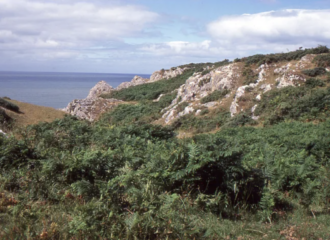
Modified state 3 – Bracken/grassland mosaic
In areas of calcareous grassland that have been under-managed, neglected or abandoned, the habitat can be invaded by bracken (Pteridium aquilinum) and become difficult to fully restore, particularly after a prolonged period of bracken domination.

